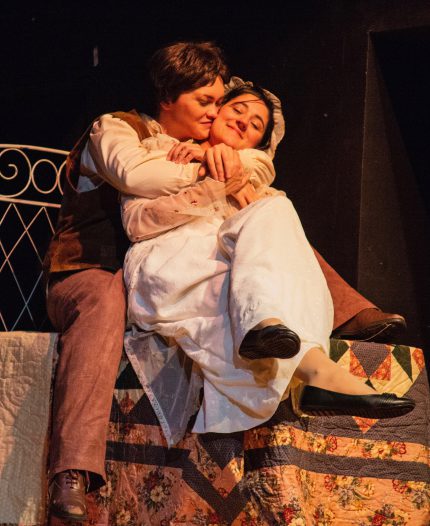Third Eye cast and staging impress in musically uneven “Patience & Sarah”

It’s 1816, and a small Connecticut town is in for a scandal. A conspicuously unmarried, well-to-do woman falls for a trouser-wearing, lumber-hauling tomboy, but the priggish, Puritan community is having none of it. In a pre-Seneca Falls world, what are two star-crossed lesbian lovers to do?
That’s the question plaguing Patience & Sarah, an opera by composer Paula M. Kimper and librettist Wende Persons. Premiered at Lincoln Center in 1998, Patience & Sarah is based on the 1969 novel of the same name by Isabel Miller (the nom de plume of writer Alma Routsong), which in turn is based on the true story of American painter Mary Ann Willson.
Directed by Jennifer Cox, Third Eye Theatre Ensemble’s new staging at the Theater Wit brings the opera back to Chicago, where it was last heard in 2000. (Coincidentally, it was performed in the same space, then the Bailiwick Repertory Theatre.)
The lovers in question, Patience White (soprano Diana Stoic) and Sarah Dowling (mezzo-soprano Liana Gineitis), are drawn to each other in part because each feels trapped by the social mores of the era. Patience, who lives with her brother Edward (tenor Dennis Kalup) and sister-in-law Martha (mezzo-soprano Rena Ahmed), paints as a hobby, but wants to make it her profession. Sarah, who helps her destitute father (bass Kota Terrace) work the family farm, wants to strike out west to become a landowner herself.
During their second meeting—and before they’ve even confessed their feelings for one another—the two vow to move to upstate New York together. When their affair is uncovered by the end of the first act, things predictably go south, and Sarah leaves town. However, in defiance of the trope that gay stories must end in death or unhappiness, the opera’s ending is open-ended but hopeful.
Ultimately, two things are true about Patience & Sarah. One is that, in the 20 years since its premiere, it has rarely been fully staged (though it certainly has a better track record than plenty of other contemporary operas). Institutional biases against women composers and, especially, against lesbian storylines, likely made Patience & Sarah a tough sell.
But the second inconvenient truth is that Patience and Sarah is a profoundly inconsistent opera. The aesthetic of Kimper’s score is appropriate to the opera’s time and milieu, with an idiomatic folkishness and sentimental candor.
Yet her music fails to serve the drama of its subject material, offering few scenes with significant musical or emotive contrast. Persons’s libretto is no help, hampered by prose where endearing simplicity veers into outright banality by opera’s end.
Friday’s talented cast nonetheless made a winning case for this uneven work.
Stoic impressed with a flexible and glittering soprano and dramatically etched a deeply emotive portrayal of Patience. Gineitis was a revelation as Sarah: her mezzo was expressive and assured throughout, embodying the role with an easy, dashing confidence.
Baritone Stephen Hobe overcame initial pitchiness to serve up a musically and dramatically potent interpretation of Parson Daniel Peel, the unexpectedly endearing ex-clergyman who briefly takes Sarah under his wing. Though technically in a supporting role, Kalup deserves special plaudits for his rich, full-toned contributions as Edward.
Ahmed and Terrace made scowling turns as (respectively) Patience and Sarah’s hostile relatives, though both might have opted for more bite and verve to their vocal delivery. Soprano Tracey Lynne Furling and mezzo-soprano Evita Trembley rounded out the Dowling clan as Sarah’s sister and mother—Furling every bit the naïve, ebullient sister, and Trembley the worn matriarch.
Third Eye set designer Jimmy Jagos underscored the women’s class conflict with a simple but elegant scent design that contrasted the interiors of their family homes—Sarah’s bare, Patience’s handsomely though not lavishly appointed.
The current production showcases Kimper’s recent chamber reduction for violin, cello, piano, French horn, flute (doubling piccolo), clarinet (doubling bass clarinet), and oboe (doubling English horn), halving the forces of her original instrumentation.
Conductor Alexandra Enyart, who helmed the ensemble in Chicago Fringe Opera’s As One last season, again demonstrated why she is a podium talent to watch. She directed the lean ensemble with finesse, control, and technical grace, though her forward-driving pace left one wanting the opera’s more tender moments to breathe a bit more.
Patience & Sarah runs with alternating casts through October 21. There will be post-concert conversations with librettist Wende Persons October 6 and composer Paula M. Kimper and Louise Brodie, Alma Routsong’s daughter, on October 20. thirdeyete.com
Posted in Performances




